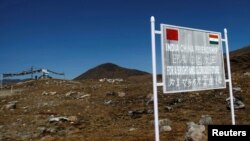India says its troops foiled an attempt by Chinese soldiers to encroach into Indian territory last week resulting in a clash along their disputed border in the eastern state of Arunachal Pradesh.
The incident is the most serious face-off between the Asian giants since a skirmish in another part of their Himalayan frontier in 2020 killed 20 Indian and four Chinese soldiers and caused ties to plummet.
“On December 9, Chinese troops tried to unilaterally change the status quo by encroaching along the line of actual control in the Yangtse area of Tawang sector,” Defense Minister Rajnath Singh told parliament on Tuesday. He said a scuffle ensued and the “Indian Army bravely prevented the PLA [People’s Liberation Army] from transgressing into our territory and compelled them to withdraw to their posts.”
According to the Indian minister, no Indian soldier was killed or seriously wounded in the clash.
Beijing did not comment on the clash but said the situation along the border was calm and called on India to “together safeguard the peace and tranquility of the India-China border.”
“As far as we understand, the China-India border situation is peaceful and stable overall and both sides have maintained smooth communications on boundary-related issues through diplomatic and military channels,” foreign ministry spokesman Wang Wenbin said in Beijing at a daily briefing.
Indian military commanders had met their Chinese counterparts on December 11 to ask their Chinese counterparts to maintain peace, according to the Indian minister.
An Indian army statement had said earlier that and both sides “immediately disengaged from the area” after the face-off.
The army gave no details of the clash, but the Indian Express newspaper quoted sources as saying that there was “intense hand-to-hand combat with sticks and canes for a few hours.” Indian media reports said hundreds of soldiers were involved in the clash.
The latest clash site lies in Tawang sector in Arunachal Pradesh state, controlled by New Delhi but also claimed by Beijing.
The Indian and Chinese border has been volatile since the deadly skirmish between soldiers of the two Asian giants took place in June 2020 in Ladakh toward the west.
The nearly 3,500-kilometer frontier in the Himalayan mountains runs from Ladakh in the west to Arunachal Pradesh in the east and is called the line of actual control.
Protracted talks between their military commanders since that clash have resulted in troops disengaging from several so-called “friction” points towards the west. But both sides continue to deploy tens of thousands of soldiers backed with artillery tanks and fighter jets and are racing to build infrastructure along their Himalayan border.
“The latest face-off indicates that the clash in 2020 in Ladakh was not a one-off event. Now, they have opened another area in the east,” according to Manoj Joshi, a fellow at the Observer Research Foundation in New Delhi.
Arunachal Pradesh, which Beijing refers to as South Tibet, is one of the areas where India has strengthened defenses. During a war that the two countries fought in 1962, Chinese troops had entered deep into the state, but later handed it back to Indian control.
The clash took place two days after Indian foreign minister, Subrahmanyam Jaishankar, told parliament that India has been “very clear with the Chinese” that New Delhi will not tolerate attempts to “unilaterally” change the line of actual control.
“So long as they continue to seek to do that and if they have built up forces which in our minds constitute a serious concern in the border areas, then our relationship is not normal and the abnormality of that has been in evidence in the last two years,” he said.
Analysts said the latest confrontation indicates that there is little prospect of a thaw in relations between New Delhi and Beijing.
“The clash in Tawang means relations between the two sides are not likely to improve anywhere in the near future. The Chinese are not backing off on their claims along the border,” analyst Joshi said.







